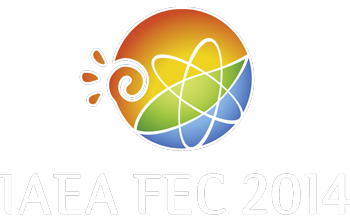Speaker
Dr
Federica Causa
(ENEA C. R. Frascati)
Description
In the 2013 experimental campaign a novel optical diagnostic system, based on the Cherenkov effect, was installed on FTU, in collaboration with the NCBJ group (IPPLM Association) to study the dynamics of non-thermal electrons in the presence of magnetic islands.
Data from the Cherenkov probe was correlated with data from several other diagnostics, including ECE, neutron and gamma detector, Mirnov coils, soft X-ray cameras, demonstrating that the modulation of the Cherenkov signal is due to the rotation of the magnetic island. An aspect of interest under investigation is the internal structure of the peaks of the Cherenkov signal, with sub-peak full-width at half maximum of the order of 10 microseconds, and approximately 20 microseconds sub-peak separation. This level of detail opens up new possibilities for the investigation of fast electrons dynamics in the presence of high-amplitude magnetic islands. The study will present the analysis of the experimental data focusing on the identification of the mechanisms and evidence of electron acceleration that can be extracted from the correlation with the magnetic island position and geometry during tearing mode instabilities. This work is in the initial phase; future work is planned to enable energy discrimination of the incoming electrons (for example through the implementation of a multi-channel probe), as well as an increase of the spatial information (by installing a second probe).
| Country or International Organisation | Italy |
|---|---|
| Paper Number | EX/P2-49 |
Author
Dr
Federica Causa
(ENEA C. R. Frascati)
Co-authors
Mr
Basilio Esposito
(ENEA)
Dr
Edmondo Giovannozzi
(ENEA C. R. Frascati)
Dr
Gianluca Pucella
(ENEA)
Dr
J. Zebrowski
(National Centre for Nuclear Research (NCBJ))
Dr
Karol Malinowski
(National Centre for Nuclear Research (NCBJ))
Dr
L Jakubowski
(National Centre for Nuclear Research (NCBJ))
Dr
M. J. Sadowski
(National Centre for Nuclear Research (NCBJ))
Dr
Marek Rabinski
(National Centre for Nuclear Research (NCBJ))
Dr
Paolo Buratti
(ENEA)

